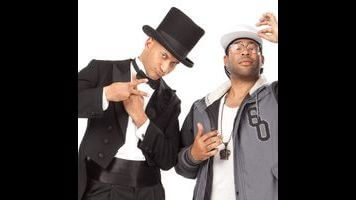Key & Peele: "Season Three, Episode Seven"

Sketch comedy is such a liberating format that its Halloween episode isn’t confined to realistic Halloween scares, which always turn out to be pranks on sitcoms and weird serial killers on procedurals. Key & Peele is so nerdy it can go all over the horror genre with acuity, and it has the visual panache to nail not only what’s on-screen but the camera clichés themselves in a one-stop Halloween shop of sketches: a fraught but self-evidently ridiculous frat-house meeting over the bad roommate, a poltergeist; the unpretentious critique of vampire chic we’ve all been waiting for; even an apparently Halloween-unrelated comedy about a man who just can’t get enough of his continental breakfast.
That’s the sketch that really takes me for a ride, and in retrospect it’s clearly the best—original, off-kilter, hilarious. At first I can’t understand why it’s in this episode, and I’m a little disappointed that we don’t get a full episode of horror parody. What, they couldn’t have some fun with You’re Next or Carrie? And then Peele investigates a spork—“Not a spoon, not a fork, but something in between, a fpork!”—and I see its goofy value for what it is. I mean Peele just bites into an unpeeled banana and admires, “Baked to perfection!” That’s no throwaway. And then it becomes the one sketch that genuinely scares me. You know exactly how it’s going to end once Key tells Peele he’s always been there, but then when Key slowly turns and smiles at the camera, the creepiness is overwhelming. It’s a simple idea, the self-consciousness of breaking the fourth wall, but what a surreal way to heighten the more restrained chill of the shot-for-shot parody of The Shining finale. Characters on television just aren’t supposed to look at you. Especially not in ghost stories.
Mostly, the episode is a great chance to assess the state of horror entertainment. On Key & Peele (and by extension The Walking Dead), the great mob menace of George A. Romero is reduced to four extras in fantastic make-up in a cage. They’ve been beaten by a handsome Hollywood hero who’s really trying to find the ambivalence in being chased by zombies. “The ambivalence is art, it’s gorgeous, and we love it. But there are zombies, so if we could just pick up the pace just a hair, that’d be great,” the director says at him. And I can’t say enough about the aesthetic, the shadowy assured widescreen of the film itself and the shaky Making Of documentary camerawork behind the scenes where all the actors’ insecurities come out. Combine with a line as left-field as Peele’s squeal, “Wassup, Obama, baby?” and the sketch is cobbled together from a few different ideas, but there’s meat on every bone: the sad state of zombies, the collaborative artistic process, Extras-style self-debasement immortalized in lines like, “You get featured if you lunge at somebody and then you get a bump in your pay, and if you really lucky, man, they blow your head off. That’s straight bank right there.”
Meanwhile, modern vampires, the children of Anne Rice and Underworld, crumble under even the slightest scrutiny, beginning with stage banter mocking the very concept of hot, pale, emo-kid vampires: “Like, who wants to fuck monsters?” At the great feast of a, uh, Nosferatu of vampires, Brother Tyrell shows up late wearing a red track suit and wife-beater ensemble. “Are you two even lesbians?” he asks the two brides of Dracula who are writhing all over each other on the sidelines. Turns out one of them has a boyfriend. If they would have made slightly less of a production out of feasting on some new victim, Brother Tyrell might not have even said anything (“If we gon’ eat, then let’s eat, damn!”). Good thing Brother Cyrus provoked him by asking why he doesn’t have any black clothes, preferably with holes up the side so you can see skin, because “This is just straight-up gratuitous” is all I will be able to think about watching any post-1990 vampire movie outside of Let The Right One In from now on.
Then there’s torture porn, which seems to be on the way out in favor of haunted houses, but remember: double-tap. So Atencio gives us a few establishing shots—an overhead of a torture chamber that evokes a public restroom, portraits of an amputated Peele and Key with a gaping thigh wound, both chained against grimy, blood-smeared walls—and then the first two lines: Key says “Could be worse” on top of Peele’s sing-song-y “Not that bad.” They find liberation in accepting death. The Jigsaw-looking madman squeals, “You fools, blabbering away! Your suffering has only just begun.” To which Key responds, “Wow, that is a perfect summation of the human condition. Once you’ve embraced that you can do anything.” That’s not just a backwards way into parody, the tortured becoming the torturers. It’s a critique of torture porn. The movies—at least, the ones that apply—aren’t scary because they’re so overbearing that you’re bludgeoned into accepting the outcome from the get-go. At the end the torturer sort of cry-laughs, “Why are you doing this to me?!” and then shouts at the heavens. What a perfect image to mark the decline of this subgenre.
Stray observations:
- The real horror: no Metta World News for this Purgeday, October Shark Zombi.
- Peele’s silver lining, chained in the torture prison: “All this time away from my computer, my phone, my work… I feel unplugged.”
- A rat comes to nip at Key’s thigh wound, and Key and Peele coo, “Aww.”